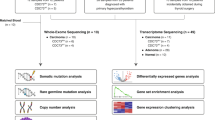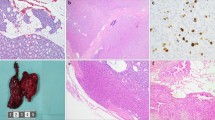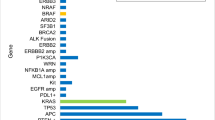Abstract
Context
Parathyroid carcinoma (PC) is a rare endocrine malignancy with no approved systemic therapies for unresectable locally invasive or distant metastatic disease. Understanding the molecular changes in advanced PC can provide better understanding of this disease and potentially help directing targeted therapy.
Objective
To evaluate tumor-specific genetic changes using next-generation sequencing (NGS) panels.
Design
All patients with advanced PC were tested for hot-spot panels using NGS panels including a 50-gene panel, a 409-gene panel if the standard 50-gene panel (Ion Torrent, Life Technology) was negative or a FoundationOne panel.
Setting
The University of Texas MD Anderson Cancer Center, Houston, Texas, USA.
Patients or other participants
11 patients with advanced PC were selected to undergo molecular testing.
Main outcome measure(s)
Genetic profiles of advanced PC.
Results
Among the 11 patients, 4 patients had the 50-gene panel only, 6 had 409-gene panel after a negative 50-gene panel and 1 had FoundationOne. One patient who had 50-gene panel only also had his metastatic site (esophagus) of his tumor tested with FoundationOne. The most common mutations identified were in the PI3 K (PIK3CA, TSC1 and ATM) (4/11 patients) and TP53 (3/11) pathways. Genes not previously reported to be mutated in PC included: SDHA, TERT promoter and DICER1. Actionable mutations were found in 54% (6/11) of the patients.
Conclusions
Mutational profiling using NGS panels in advanced PC has yielded important potentially targetable genetic alterations. Larger studies are needed to identify commonly mutated genes in advanced PC patients. Development of novel therapies targeting these cellular pathways should be considered.

Similar content being viewed by others
References
Agha A, Carpenter R, Bhattacharya S, Edmonson SJ, Carlsen E, Monson JP (2007) Parathyroid carcinoma in multiple endocrine neoplasia type 1 (MEN1) syndrome: two case reports of an unrecognised entity. J Endocrinol Invest 30(2):145–149
Bihani T, Ezell SA, Ladd B, Grosskurth SE, Mazzola AM, Pietras M, Reimer C, Zinda M, Fawell S, D’Cruz CM (2015) Resistance to everolimus driven by epigenetic regulation of MYC in ER+breast cancers. Oncotarget 6(4):2407–2420
Burchett KM, Yan Y, Ouellette MM (2014) Telomerase inhibitor imetelstat (GRN163L) limits the lifespan of human pancreatic cancer cells. PLoS One 9(1):e85155
Burnichon N, Briere JJ, Libe R, Vescovo L, Riviere J, Tissier F, Jouanno E, Jeunemaitre X, Benit P, Tzagoloff A, Rustin P, Bertherat J, Favier J, Gimenez-Roqueplo AP (2010) SDHA is a tumor suppressor gene causing paraganglioma. Hum Mol Genet 19(15):3011–3020
Busaidy NL, Jimenez C, Habra MA, Schultz PN, El-Naggar AK, Clayman GL, Asper JA, Diaz EM Jr, Evans DB, Gagel RF, Garden A, Hoff AO, Lee JE, Morrison WH, Rosenthal DI, Sherman SI, Sturgis EM, Waguespack SG, Weber RS, Wirfel K, Vassilopoulou-Sellin R (2004) Parathyroid carcinoma: a 22-year experience. Head Neck 26(8):716–726
Cantley LC (2002) The phosphoinositide 3-kinase pathway. Science 296(5573):1655–1657
Celeghin A, Giunco S, Freguja R, Zangrossi M, Nalio S, Dolcetti R, De Rossi A (2016) Short-term inhibition of TERT induces telomere length-independent cell cycle arrest and apoptotic response in EBV-immortalized and transformed B cells. Cell Death Dis 7(12):e2562
Cetani F, Pardi E, Viacava P, Pollina GD, Fanelli G, Picone A, Borsari S, Gazzerro E, Miccoli P, Berti P, Pinchera A, Marcocci C (2004) A reappraisal of the Rb1 gene abnormalities in the diagnosis of parathyroid cancer. Clin Endocrinol (Oxf) 60(1):99–106
Cetani F, Pardi E, Marcocci C (2016) Update on parathyroid carcinoma. J Endocrinol Invest 39(6):595–606
Christakis I, Busaidy NL, Cote GJ, Williams MD, Hyde SM, Silva Figueroa AM, Kwatampora LJ, Clarke CN, Qiu W, Lee JE, Perrier ND (2016) Parathyroid carcinoma and atypical parathyroid neoplasms in MEN1 patients; a clinico-pathologic challenge The MD Anderson case series and review of the literature. Int J Surg 31:10–16
Christakis I, Silva AM, Williams MD, Garden A, Grubbs EG, Busaidy NL, Lee JE, Perrier ND, Zafereo M (2017) Postoperative local-regional radiation therapy in the treatment of parathyroid carcinoma: the MD Anderson experience of 35 years. Pract Radiat Oncol 7(6):e463–e470
Cryns VL, Rubio MP, Thor AD, Louis DN, Arnold A (1994) p53 abnormalities in human parathyroid carcinoma. J Clin Endocrinol Metab 78(6):1320–1324
Curatolo P, Maria BL (2013) Tuberous sclerosis. Handb Clin Neurol 111:323–331
DeLellis R (2004) Pathology and genetics of tumours of endocrine organs. IARC Press, Lyon, France
Dunford A, Weinstock DM, Savova V, Schumacher SE, Cleary JP, Yoda A, Sullivan TJ, Hess JM, Gimelbrant AA, Beroukhim R, Lawrence MS, Getz G, Lane AA (2017) Tumor-suppressor genes that escape from X-inactivation contribute to cancer sex bias. Nat Genet 49(1):10–16
Dwight T, Mann K, Benn DE, Robinson BG, McKelvie P, Gill AJ, Winship I, Clifton-Bligh RJ (2013a) Familial SDHA mutation associated with pituitary adenoma and pheochromocytoma/paraganglioma. J Clin Endocrinol Metab 98(6):E1103–E1108
Dwight T, Benn DE, Clarkson A, Vilain R, Lipton L, Robinson BG, Clifton-Bligh RJ, Gill AJ (2013b) Loss of SDHA expression identifies SDHA mutations in succinate dehydrogenase-deficient gastrointestinal stromal tumors. Am J Surg Pathol 37(2):226–233
Foulkes WD, Priest JR, Duchaine TF (2014) DICER1: mutations, microRNAs and mechanisms. Nat Rev Cancer 14(10):662–672
FoundationOne. https://assets.ctfassets.net/vhribv12lmne/6YRrchSINOeSu48YwuesoY/0c3651c8421fa3647ccede76de9dce61/MKT-0054-02_F1_TechSpecs_digital.pdf. [3/27/2018]
Frank-Raue K, Haag C, Schulze E, Keuser R, Raue F, Dralle H, Lorenz K (2011) CDC73-related hereditary hyperparathyroidism: five new mutations and the clinical spectrum. Eur J Endocrinol 165(3):477–483
Gotley DC, Reeder JA, Fawcett J, Walsh MD, Bates P, Simmons DL, Antalis TM (1996) The deleted in colon cancer (DCC) gene is consistently expressed in colorectal cancers and metastases. Oncogene 13(4):787–795
Guo Y, Chekaluk Y, Zhang J, Du J, Gray NS, Wu CL, Kwiatkowski DJ (2013) TSC1 involvement in bladder cancer: diverse effects and therapeutic implications. J Pathol 230(1):17–27
Haglund F, Juhlin CC, Brown T, Ghaderi M, Liu T, Stenman A, Dinets A, Prasad M, Korah R, Xu D, Carling T, Larsson C (2015) TERT promoter mutations are rare in parathyroid tumors. Endocr Relat Cancer 22(3):L9
Hakimi AA, Chen YB, Wren J, Gonen M, Abdel-Wahab O, Heguy A, Liu H, Takeda S, Tickoo SK, Reuter VE, Voss MH, Motzer RJ, Coleman JA, Cheng EH, Russo P, Hsieh JJ (2013) Clinical and pathologic impact of select chromatin-modulating tumor suppressors in clear cell renal cell carcinoma. Eur Urol 63(5):848–854
Hornigold N, Devlin J, Davies AM, Aveyard JS, Habuchi T, Knowles MA (1999) Mutation of the 9q34 gene TSC1 in sporadic bladder cancer. Oncogene 18(16):2657–2661
Hsieh JJ, Chen D, Wang PI, Marker M, Redzematovic A, Chen YB, Selcuklu SD, Weinhold N, Bouvier N, Huberman KH, Bhanot U, Chevinsky MS, Patel P, Pinciroli P, Won HH, You D, Viale A, Lee W, Hakimi AA, Berger MF, Socci ND, Cheng EH, Knox J, Voss MH, Voi M, Motzer RJ (2017) Genomic biomarkers of a randomized trial comparing first-line everolimus and sunitinib in patients with metastatic renal cell carcinoma. Eur Urol 71(3):405–414
https://www.thermofisher.com/order/catalog/product/4475346. [cited 2018 3/23]
https://www.thermofisher.com/order/catalog/product/4477685. [cited 2018 3/23]
Huang J, Manning BD (2008) The TSC1–TSC2 complex: a molecular switchboard controlling cell growth. Biochem J 412(2):179–190
Huynh H, Hao HX, Chan SL, Chen D, Ong R, Soo KC, Pochanard P, Yang D, Ruddy D, Liu M, Derti A, Balak MN, Palmer MR, Wang Y, Lee BH, Sellami D, Zhu AX, Schlegel R, Huang A (2015) Loss of tuberous sclerosis complex 2 (TSC2) Is frequent in hepatocellular carcinoma and predicts response to mTORC1 inhibitor everolimus. Mol Cancer Ther 14(5):1224–1235
Iyer G, Hanrahan AJ, Milowsky MI, Al-Ahmadie H, Scott SN, Janakiraman M, Pirun M, Sander C, Socci ND, Ostrovnaya I, Viale A, Heguy A, Peng L, Chan TA, Bochner B, Bajorin DF, Berger MF, Taylor BS, Solit DB (2012) Genome sequencing identifies a basis for everolimus sensitivity. Science 338(6104):221
Jackson MA, Rich TA, Hu MI, Perrier ND, Waguespack SG (1993) CDC73-Related Disorders. In: Adam MP et al (eds) GeneReviews((R)). University of Washington, Seattle
Ji X, Jin S, Qu X, Li K, Wang H, He H, Guo F, Dong L (2015) Lysine-specific demethylase 5C promotes hepatocellular carcinoma cell invasion through inhibition BMP7 expression. BMC Cancer 15:801
Kang H, Schubert AD, Ladenson P, Ball DW, Chung J, Schrock AB, Ross JS, Miller VA, Stephens PJ, Ali SM (2017) Comprehensive genomic profiling of parathyroid carcinoma. J Clin Oncol 35(15 suppl):6088
Kasaian K, Wiseman SM, Thiessen N, Mungall KL, Corbett RD, Qian JQ, Nip KM, He A, Tse K, Chuah E, Varhol RJ, Pandoh P, McDonald H, Zeng T, Tam A, Schein J, Birol I, Mungall AJ, Moore RA, Zhao Y, Hirst M, Marra MA, Walker BA, Jones SJ (2013) Complete genomic landscape of a recurring sporadic parathyroid carcinoma. J Pathol 230(3):249–260
Khoo KH, Verma CS, Lane DP (2014) Drugging the p53 pathway: understanding the route to clinical efficacy. Nat Rev Drug Discov 13(3):217–236
Knudson AG (2001) Two genetic hits (more or less) to cancer. Nat Rev Cancer 1(2):157–162
Kopetz S, Litzenburger B, Kinyua W, Sajan B, Subbiah V, Zinner R, Wheler JJ, Hong DS, Tsimberidou AM, Overman MJ, Pagliaro LC, Busaidy NL, Westin SN, Glisson BS, Heymach J, Meric-Bernstam F, Shaw KR, Lee JJ, Broaddus R (2015) Prospective evaluation of a 409-gene next generation sequencing platform to facilitate genotype-matched clinical trial enrollment. J Clin Oncol 33(15 suppl):3608
Lazaris AC, Tseleni-Balafouta S, Papathomas T, Brousalis T, Thomopoulou G, Agrogiannis G, Patsouris ES (2006) Immunohistochemical investigation of angiogenic factors in parathyroid proliferative lesions. Eur J Endocrinol 154(6):827–833
Le Tourneau C, Raymond E, Faivre S (2007) Sunitinib: a novel tyrosine kinase inhibitor. A brief review of its therapeutic potential in the treatment of renal carcinoma and gastrointestinal stromal tumors (GIST). Ther Clin Risk Manag 3(2):341–348
Liu Z, Hou P, Ji M, Guan H, Studeman K, Jensen K, Vasko V, El-Naggar AK, Xing M (2008) Highly prevalent genetic alterations in receptor tyrosine kinases and phosphatidylinositol 3-kinase/Akt and mitogen-activated protein kinase pathways in anaplastic and follicular thyroid cancers. J Clin Endocrinol Metab 93(8):3106–3116
Matsui J, Funahashi Y, Uenaka T, Watanabe T, Tsuruoka A, Asada M (2008) Multi-kinase inhibitor E7080 suppresses lymph node and lung metastases of human mammary breast tumor MDA-MB-231 via inhibition of vascular endothelial growth factor-receptor (VEGF-R) 2 and VEGF-R3 kinase. Clin Cancer Res 14(17):5459–5465
Mosrati MA, Malmstrom A, Lysiak M, Krysztofiak A, Hallbeck M, Milos P, Hallbeck AL, Bratthall C, Strandeus M, Stenmark-Askmalm M, Soderkvist P (2015) TERT promoter mutations and polymorphisms as prognostic factors in primary glioblastoma. Oncotarget 6(18):16663–16673
NEXAVAR Prescribing Information (2018) Bayer HealthCare Pharmaceuticals, Inc; Whippany, NJ
Owonikoko TK, Khuri FR (2013) Targeting the PI3 K/AKT/mTOR pathway: biomarkers of success and tribulation. Am Soc Clin Oncol Educ Book 33:e395
Pandya C, Uzilov AV, Bellizzi J, Lau CY, Moe AS, Strahl M, Hamou W, Newman LC, Fink MY, Antipin Y, Yu W, Stevenson M, Cavaco BM, Teh BT, Thakker RV, Morreau H, Schadt EE, Sebra R, Li SD, Arnold A, Chen R (2017) Genomic profiling reveals mutational landscape in parathyroid carcinomas. JCI Insight 2(6):e92061
Paolicchi E, Crea F, Farrar WL, Green JE, Danesi R (2013) Histone lysine demethylases in breast cancer. Crit Rev Oncol Hematol 86(2):97–103
Robles-Espinoza CD, Harland M, Ramsay AJ, Aoude LG, Quesada V, Ding Z, Pooley KA, Pritchard AL, Tiffen JC, Petljak M, Palmer JM, Symmons J, Johansson P, Stark MS, Gartside MG, Snowden H, Montgomery GW, Martin NG, Liu JZ, Choi J, Makowski M, Brown KM, Dunning AM, Keane TM, Lopez-Otin C, Gruis NA, Hayward NK, Bishop DT, Newton-Bishop JA, Adams DJ (2014) POT1 loss-of-function variants predispose to familial melanoma. Nat Genet 46(5):478–481
Rokman A, Ikonen T, Seppala EH, Nupponen N, Autio V, Mononen N, Bailey-Wilson J, Trent J, Carpten J, Matikainen MP, Koivisto PA, Tammela TL, Kallioniemi OP, Schleutker J (2002) Germline alterations of the RNASEL gene, a candidate HPC1 gene at 1q25, in patients and families with prostate cancer. Am J Hum Genet 70(5):1299–1304
Schaffner C, Idler I, Stilgenbauer S, Dohner H, Lichter P (2000) Mantle cell lymphoma is characterized by inactivation of the ATM gene. Proc Natl Acad Sci USA 97(6):2773–2778
Schulte KM, Talat N (2012) Diagnosis and management of parathyroid cancer. Nat Rev Endocrinol 8(10):612–622
Shattuck TM, Valimaki S, Obara T, Gaz RD, Clark OH, Shoback D, Wierman ME, Tojo K, Robbins CM, Carpten JD, Farnebo LO, Larsson C, Arnold A (2003) Somatic and germ-line mutations of the HRPT2 gene in sporadic parathyroid carcinoma. N Engl J Med 349(18):1722–1729
Shayesteh L, Lu Y, Kuo WL, Baldocchi R, Godfrey T, Collins C, Pinkel D, Powell B, Mills GB, Gray JW (1999) PIK3CA is implicated as an oncogene in ovarian cancer. Nat Genet 21(1):99–102
Singh RR, Patel KP, Routbort MJ, Reddy NG, Barkoh BA, Handal B, Kanagal-Shamanna R, Greaves WO, Medeiros LJ, Aldape KD, Luthra R (2013) Clinical validation of a next-generation sequencing screen for mutational hotspots in 46 cancer-related genes. J Mol Diagn 15(5):607–622
Singh RR, Patel KP, Routbort MJ, Aldape K, Lu X, Manekia J, Abraham R, Reddy NG, Barkoh BA, Veliyathu J, Medeiros LJ, Luthra R (2014) Clinical massively parallel next-generation sequencing analysis of 409 cancer-related genes for mutations and copy number variations in solid tumours. Br J Cancer 111(10):2014–2023
Stracquadanio G, Wang X, Wallace MD, Grawenda AM, Zhang P, Hewitt J, Zeron-Medina J, Castro-Giner F, Tomlinson IP, Goding CR, Cygan KJ, Fairbrother WG, Thomas LF, Saetrom P, Gemignani F, Landi S, Schuster-Bockler B, Bell DA, Bond GL (2016) The importance of p53 pathway genetics in inherited and somatic cancer genomes. Nat Rev Cancer 16(4):251–265
Vinagre J, Almeida A, Populo H, Batista R, Lyra J, Pinto V, Coelho R, Celestino R, Prazeres H, Lima L, Melo M, da Rocha AG, Preto A, Castro P, Castro L, Pardal F, Lopes JM, Santos LL, Reis RM, Cameselle-Teijeiro J, Sobrinho-Simoes M, Lima J, Maximo V, Soares P (2013) Frequency of TERT promoter mutations in human cancers. Nat Commun 4:2185
Wu J, Ellison J, Salido E, Yen P, Mohandas T, Shapiro LJ (1994) Isolation and characterization of XE169, a novel human gene that escapes X-inactivation. Hum Mol Genet 3(1):153–160
Xing M, Liu R, Liu X, Murugan AK, Zhu G, Zeiger MA, Pai S, Bishop J (2014) BRAF V600E and TERT promoter mutations cooperatively identify the most aggressive papillary thyroid cancer with highest recurrence. J Clin Oncol 32(25):2718–2726
Yu W, McPherson JR, Stevenson M, van Eijk R, Heng HL, Newey P, Gan A, Ruano D, Huang D, Poon SL, Ong CK, van Wezel T, Cavaco B, Rozen SG, Tan P, Teh BT, Thakker RV, Morreau H (2015) Whole-exome sequencing studies of parathyroid carcinomas reveal novel PRUNE2 mutations, distinctive mutational spectra related to APOBEC-catalyzed DNA mutagenesis and mutational enrichment in kinases associated with cell migration and invasion. J Clin Endocrinol Metab 100(2):E360–E364
Yuan TL, Cantley LC (2008) PI3 K pathway alterations in cancer: variations on a theme. Oncogene 27(41):5497–5510
Acknowledgements
We wish to thank Mrs. Jennifer Jordan and Mr. Len Jordan for their generous contributions that made this study possible. We thank Bryan Tutt from the Scientific Publications Department at MD Anderson Cancer Center for editing our manuscript.
Funding
Supported by the NIH/NCI under award number P30CA016672 and philanthropic donation from patients
Author information
Authors and Affiliations
Corresponding author
Ethics declarations
Conflict of interest
NLB has received grant funding from Novartis and Bayer and consulting fees from Eisai. MEC has received grant funding from Eisai. MK, HTN, LK, CC, AS, EI, SGW, CJ, MH, SS, SK, RB, RD, KW, MW, MZ, NP: nothing to disclose
Additional information
Publisher's Note
Springer Nature remains neutral with regard to jurisdictional claims in published maps and institutional affiliations.
Rights and permissions
About this article
Cite this article
Kutahyalioglu, M., Nguyen, H.T., Kwatampora, L. et al. Genetic profiling as a clinical tool in advanced parathyroid carcinoma. J Cancer Res Clin Oncol 145, 1977–1986 (2019). https://doi.org/10.1007/s00432-019-02945-9
Received:
Accepted:
Published:
Issue Date:
DOI: https://doi.org/10.1007/s00432-019-02945-9




